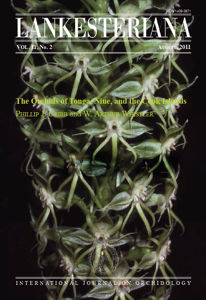The Orchids of Tonga, Niue, and the Cook Islands
DOI:
https://doi.org/10.15517/lank.v11i2.18308Abstract
Orchids are one of the largest families of flowering plants in the Pacific region, especially in the tropics. Despite the remoteness of Tonga, Niue, and the Cook Islands, orchids have reached them in some numbers. Both terrestrial and epiphytic genera are well represented in the floras of these distant but neighboring archipelagos. Most of the species are found elsewhere in the Pacific, particularly in Fiji, Samoa, and the Society Islands. The affinities of these orchids can be traced to New Guinea and the adjacent archipelagos. New Guinea, with an estimated 3000 species that make it one of the richest orchid floras in the world, is a fertile source of seed for the scattered islands that lie to its east and southeast. The orchids appear to have reached Tonga, Niue, and the Cook Islands in recent times. Only two species, Habenaria amplifolia from Rarotonga and Robiquetia tongaensis from Tonga, are endemic to the islands covered in the present book, and both are closely related to more widespread Pacific species. This guide constitutes the fourth of a series of orchid floristic treatments that have so far covered Vanuatu (Lewis & Cribb 1989), the Solomon Islands and Bougainville (Lewis & Cribb 1991), and Samoa (Cribb & Whistler 1996). A recent, excellent and detailed account of the Fijian orchid flora (Kores 1991) has also been a valuable source for those interested in Pacific islands orchids. These accounts have generated renewed interest in the orchid floras of those archipelagos, leading to new discoveries and re-interpretations of several species. We hope that this small guide will likewise bring a renewal of interest in not only the orchids, but also the floras of these islands as a whole.
Downloads
Downloads
Published
How to Cite
Issue
Section
License
According to the Open Access policy promoted by the University of Costa Rica, all the papers published by Lankesteriana are licensed under the Creative Commons copyright and can be downloaded free of charge. The journal holds copyright and publishing rights under the CC BY-NC-ND 3.0 CR license.
Before the publication of the materials submitted by the author(s) in LANKESTERIANA, the author(s) hereby assign all rights in the article to the Lankester Botanical Garden.





